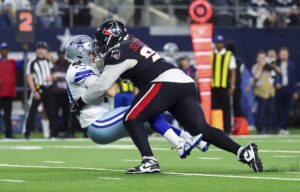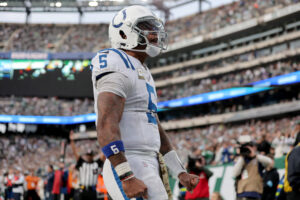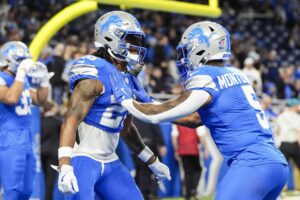If you have missed any ‘Implication of Success’ articles, catch up now! Quarterback, Offensive Line, Wide Receiver Tight End
“You cannot win, if you cannot run” is one of the empirical truths of football as laid out by Kansas City Chiefs legendary coach Hank Stram. Although the NFL has changed a lot since the 1960s, the demand for a powerful running game in Arrowhead Stadium persists. Whether it was Priest Holmes or Jamaal Charles, the Chiefs have thrived on wearing out defenses. However, in 2017 for the first time the Chiefs do not have a foundation back, rather a system of backs. The Kansas City Chiefs running backs system must be defined in 2017 as powerful and unpredictable to scheme against. Spencer Ware or rookie Kareem Hunt do not need to be individually legendary; but when their number is called they need to force defenses to scheme for different skill sets.
Kansas City Chiefs Running Backs Defining Moments of Success
Forcing Variety
Finding running backs in the NFL that are true foundation backs is a rarity. The Dallas Cowboys have one in Ezekiel Elliott. The Chiefs had one in Jamaal Charles healthy seasons. Hence, a running back that can take the field in passing, running, power sets, sweep sets, and blocking scenarios. The demand for that variety of skills in one running back is a load on the human body, subsequently making it a rarity. To mitigate the need for a foundation back, the NFL has moved to building running back systems based on primary and secondary backs.
In the Chiefs system of running backs, however, the picture is a bit muddled heading into the 2017 season. Featuring six running backs that all have unique skill sets, training camp is going to be competitive for the differing roles. Ware and Hunt will battle it out for the primary role, with the early favorite being Spencer Ware due to his veteran presence. The secondary back role is likely to go toward Hunt, but never count out Charcandrick West or C.J. Spiller. Both are veterans that can take on a secondary role, leaving Hunt to a third role as he learns.
No matter where players align in the system of head coach Andy Reid and running back coach Eric Bieniemy each alignment demands specific functions. The primary back will be used on first and second downs for A and B gap runs, with the ability to run sweeps on occasion. Chiefs game plans have predominantly favored inside runs opposed to sweeps over the tackle or nine-hole. The secondary back in 2017 may see more sweeps to introduce variety. Ware is the favorite to run through the A and B gap, while Hunt will be better at counter trap runs that trend toward the outside.
The other various schemes the Chiefs can use is a passing back on third down. Spiller has taken over this role during his tenure with the Buffalo Bills and New Orleans Saints, and if he makes the Chiefs he will assume that role part time. However, his tenure may not be long as Hunt has shown desire to take over as an all-down back, including improving receiving skills.
However, Tyreek Hill out of the backfield introduces an entirely different running set for the Chiefs. He can line up in the wildcat and power through the middle of the field, or align offset and take a sweep wide. Hill’s versatility as a pass catcher or blazing runner will allow for deception in alignments. Defenses will be forced to scheme for multiple plays coming out of one play set.
Anthony Sherman and the Power Set
One of the most overlooked positions in football is the dying scheme of the fullback. However, Andy Reid has one of the best in Anthony Sherman, and uses him wisely.
The fullback was traditionally used as a tail back that could line up to block or run on shorter downs. However, as the NFL moved to a pass centric league, shotgun formations became more prevalent, and fullbacks were no longer worth a roster spot. Thus, power running backs and H-back tight ends were born.
However, some schemes, particularly the west coast offense, integrated fullbacks into passing sets. As an H-back, the full back in an ideal west coast offense can either lead block, run in tight sets, or catch out of the back field as a ‘check-down’ receiver. Mack Strong of the Seattle Seahawks or Mike Alstott of the Tampa Bay Buccaneers was the epitome of a west coast fullback.
I bring up the following to state what Sherman ideally should be. The highest paid tailback on the Chiefs, Sherman ought to be utilized in varying ways during 2017. He currently is one of the most important team leaders on special teams, and an excellent blocker in all sets. However, in 2013 and 2014, he flashed the ability to be a pass receiver out of the back field.
If Andy Reid re-institutes such a methodology, Sherman will be a third force for defenses to scheme around. Not only will his physicality open the end zone, but it will be a way for the Chiefs to score. In the synthesis of the set, the Chiefs could align in a three-back set with Sherman as the lead, and Ware/Hunt offset to Tyreek Hill in a split back. Out of that one formation the Chiefs could run over 20 different plays and defenses would need to be prepared for all 20 variations. That is a dream that Hank Stram would love to have.
Production
The benefit of a system of running backs is there is no demand for a singular 1,000-yard rusher. It is always a benefit to have the primary back be that 1,000-yard back, but demanding it out by pure volume harms the team. The emphasis for the primary back ought to be on yards per carry, as that shows true efficiency. Whether that be Spencer Ware or Kareem Hunt, the mark is a minimum of 4.3 yards per carry.
Touchdowns for the primary back are an interesting subject. If Ware wins the job he needs to have five. However, if Hunt takes the job he may only have two. Hunt’s skills are fit for the middle of the field, to get explosive runs from between the 20 yard lines; Ware is fit for every zone of the field at this point in his career. Idealistically, Anthony Sherman will add onto this another goal line touchdown.
Many of the Chiefs running backs have the ability to pop in scores from beyond the red zone. Tyreek Hill, C.J. Spiller, and even Kareem Hunt are explosive runners that can carry a brunt of the passing game. Hill ought to have four rushing touchdowns and eight passing touchdowns, symbolic of his heavier use in the tailback slot, and the remaining backs should tack on five receiving scores. If Hunt finds breakaway runs this season, he could raise his total touchdown mark to five or six.
One of the telling signs of the Chiefs ability to finish on the goal line will be the lack of rushing touchdowns from Alex Smith. Last year he was forced to run for five, hence, Ware could not punch it in on the goal line. Adding Hunt may not help the situation right away. Thus, the solution turns toward Tyreek Hill and sweep plays. Ideally Hill and Spiller can carry the ball wide and score before arriving on the goal line. Yet, they also need to punch in sweeps from a mere five yards out.
2017 will be defined for the Chiefs largely in the way the individual running backs define themselves. More than a need for stats overall, Spencer Ware, Tyreek Hill, and Kareem Hunt need to fill their role with functionality and skill. If that means Ware and Hunt split for 750 yards rushing each, let it be. The beauty of a busy running back room is the differing skill sets. Use them wisely, and the Chiefs will make Hank Stram smile as they run their way to victory.






